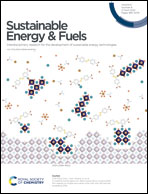The porous transport layer in proton exchange membrane water electrolysis: perspectives on a complex component
Abstract
The porous transport layer (PTL) is an essential component of the polymer electrolyte membrane water electrolyzer (PEMWE), responsible for a better utilization of the catalyst layer (CL). The PTL allows transporting the reactant water to the anode and cathode CLs, removing produced oxygen gas and providing good electrical conductivity for effective electron conduction. This calls for an optimized microstructure for PTLs to ensure stable electrochemical performance of PEMWEs. In this review, efforts are made to identify various PTLs and their properties, current status and challenges. In an attempt to identify critical parameters for PTL specifications, and facilitate material development, component characterization, and quality control, a functional analysis of PTLs is performed by breaking down main functions, supporting attributes, and associated properties, as well as existing methods and tests to measure each property. As the interface between the CL and the PTL accounts for ohmic, kinetic, and mass transport overpotentials, the importance of the PTL/CL interface is emphasized. Efforts are also made to analyze the effects of PTL properties on performance from various studies conducted by different research groups.

- This article is part of the themed collection: Sustainable Energy and Fuels Recent Review Articles


 Please wait while we load your content...
Please wait while we load your content...